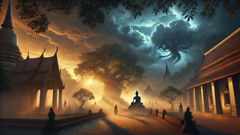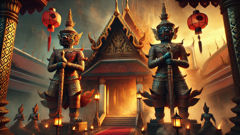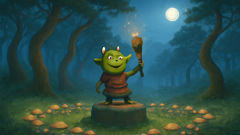Introduction
In the labyrinthine lanes of Prague’s Jewish Quarter, time has always moved differently. The Renaissance city outside bustled with silver merchants and grimy fishmongers, echoing with the clang of metalworks and the lush cadence of lutes drifting from the emperor’s halls. But within the ancient ghetto walls, life breathed beneath a different sky—a patchwork of secrets, vigilance, and centuries-old tradition. Here, in this close-knit tapestry of narrow, winding streets and candlelit homes, faith was both a solace and a shield against the pressing weight of suspicion swirling outside. Shadows crept from the alleys, leaning long over the cobblestones, as rumor and prejudice began, once again, to gnaw at the ghetto’s fragile peace. In those taut years, Prague was torn between Renaissance splendor and lingering darkness, rulers coveting power as the old fears among Gentiles festered. Stories twisted their way through the city—whispers of blood, false accusations, the word “libel” tracing icy fingers through every hearth. The Jewish Quarter’s heart thudded with anxious prayers. Precision and ritual held the world together: children chanted Torah verses while mothers kneaded dough for Sabbath, and scholars bent over their scrolls, words fluttering in candlelight. It was in this uncertain era that Judah Loew ben Bezalel—Rabbi Loew—became both shepherd and oracle for his people. The rabbi moved with quiet authority, silver-bearded and solemn, his eyes forever searching between lines of Talmud and the intricate flow of fate. As darkness pressed ever closer—one cruel rumor away from catastrophe—Rabbi Loew sought answers not in the blade or coin, but in something far more ancient. From Kabbalistic scrolls he inherited from ancestors, he discovered the forbidden legend: the way to breathe animating fire into the inert, to coax meaning and purpose from earth itself. It was in the city’s quiet hours, beneath velvet-skied midnight, that the rabbi turned to the last hope—creation born of holy words and sacred elements. Thus begins the legend of the Golem, a tale woven through Prague’s misty streets, alive with hope, mystery, and the strange dance of faith and fate.
Clay, Faith, and Fear: The Birth of the Golem
It started one Sabbath eve, with a knock at Rabbi Loew’s door. The rabbi’s modest chamber was cluttered with scrolls, lamps burning low, the air thrumming with worry. Abraham, a respected elder whose voice now quivered, relayed news that chilled the room: a child from the Christian quarter had gone missing, and whispers, wild and unchecked, were blooming—blaming the Jews. It was a pattern old as exile. The accusations, always baseless, always deadly, were not just threats. In such times, they heralded violence, mob justice, the city’s anger converging as one upon the ghetto.
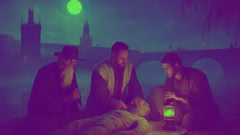
Where others saw hopelessness, Rabbi Loew saw necessity. For nights, he walked the edge of the Vltava River, murmuring prayers not just for safety, but for wisdom. The river, ancient and patient, slid by beneath Prague’s bridges, its surface shivering gold in the lamplight. There—in the silent, silt-strewn banks—Rabbi Loew found what he sought. He knelt, robes heavy with dew, drawing forth the river’s clay, cold as the fears stalking his people. With trembling reverence, he shaped the clay, folding into it the Torah’s teachings, whispers of Creation itself. Each motion was a memory, each press a prayer. Alongside the rabbi were his son-in-law, Isaac, and his faithful student, Jacob. All through that night, singing sacred psalms, they molded a giant form: arms broad as oak limbs, hands shaped to shield, a chest strong enough to withstand mortal blows.
As the clay titan took shape under flickering lanterns, Loew recited secret Kabbalistic formulae. The air grew thick with anticipation. Ceremonially, they inscribed upon the figure’s brow the word “emet”—truth—etching it deep with trembling fingers. Then, one by one, they circled the form, chanting invocations that drew the borders between spirit and matter. A gust of wind swept inside the hidden chamber, and the Golem stirred. First, a faint sigh, as though the clay exhaled centuries of earthbound dreams. Then, eyelids flickered. The Golem sat upright, its gaze vast, amber, and unreadable, fresh eyes beholding an unfamiliar world.
Word spread like sparks—discreetly at first—through the ghetto. Some believed the Golem would be their ruin, tempting fate and divine wrath. Most, though, saw hope embodied in the clay—a living wall between terror and fragile life. The Golem, towering and stoic, was soon clothed in worker’s garb. Its creator named it Josef, after a patriarch who bore burdens for others. Each dawn, the Golem roamed the narrow streets, eyes tracing faces and doors, silent as the stone lions perched above synagogue doors. The few gentiles who glimpsed the Golem hurried away, shrouded in awe and rumor, rumors blooming through Prague as “that giant in the ghetto” who could not be stopped.
Its strength soon proved invaluable. When an angry mob, goaded by a sinister local magistrate, charged the ghetto’s main gate, expecting easy prey, they met Josef instead—a colossus whose mere presence stalled rage and turned swords to stumbling. He stood unmoved as stones pelted, his clay shoulders absorbing hatred with silent defiance. Not a soul died on either side that night, for the Golem never killed. Instead, he shielded, turned aside violence, crushed no living being but broke no vow of faith. The people of Prague buzzed with curiosity, some fearful, some enraptured. By moonlight, the Golem walked the courtyards, repairing shattered windows, gathering broken bread, always gentle with the smallest children who reached for his massive, dust-streaked hands. The stories spread, weaving Josef into the warp and weft of Prague’s fate.
Yet for all his power, the Golem was but an instrument—a miracle bound to the discipline of word and will. Rabbi Loew’s wisdom called for vigilance. Weekly, at twilight, he, Isaac, and Jacob met in secret to recite safeguard verses over the Golem, ensuring its soul of clay remained tethered to mercy and not to untamed wrath. None could have known how easily a single word or moment might shift peace to peril.
Protector Amid Shadows: The Golem’s Courage
Josef the Golem became both guardian and legend for the Jewish Quarter—a living myth striding amid real dangers. For months, peace returned to Prague’s ghetto. The children played under the Golem’s patient watch, knowing no thief or ruffian would dare trespass. Merchants again opened their shutters wide; Sabbath songs spilled into the alleys. Loew’s miracle had given the city’s Jews more than a protector; it gave them back joy, even if the outside world waited, watching for the Golem’s next move.

But not everyone in Prague was content to let miracles be. Word of the clay colossus reached the ears of Rudolph II, the Holy Roman Emperor—a man fascinated by secrets, alchemy, and things forbidden. The Emperor summoned Rabbi Loew to Prague Castle, its turrets and halls casting long shadows over the city. At court, surging with curious officials and men of science, Loew was received with anxious awe. Rudolph II posed the question all the city pondered: Did Rabbi Loew possess the true secret of creation? Could he, perhaps, create life where there should be none? Ever wise, Loew answered in parables, careful to shield his people from imperial curiosity. He assured the Emperor that the Golem was but a metaphor—a story, a warning, and a lesson, never a threat to the city he loved. The emperor, both relieved and skeptical, agreed to look away, so long as the Golem remained a myth in the shadows and Prague’s peace held.
Yet darkness, as always, bred in secret corners. One winter’s eve, a jealous merchant—his business ruined by rumors of “Jewish sorcery”—plotted with the city’s most virulent priests to expose the Golem for the wider world. Their schemes led them to orchestrate another accusation, more malignant than any before. This time, kidnappers spirited away a local child and hid her within abandoned wine cellars, planning to pin the disappearance on the quarter.
Josef’s strength, though silent, was never idle. Guided by the prayers of the ghetto’s worried mothers, the Golem prowled Prague’s cellars, his presence now a rumor threaded through every whisper of the city. When he found the terrified child, he freed her, returning her unharmed, her cheeks tear-stained, to the arms of her parents amid the startled city folk. The mob, ready to ignite, fell silent as Josef brought to light the merchant’s villainy. In the wake of the uproar, the truth could no longer be denied: the Golem’s presence was a bulwark against lies and violence, his might a silent rebuke to all who would stoke fear.
As moon after moon passed, Josef’s legend grew. Some nights, gentle hands left bread and dried figs by his silent post. Shy children attempted to draw his likeness in charcoal on synagogue walls. The old women named him “one who answers prayers.” Josef began to comprehend not only duty, but kindness: though mute, he learned to bow to elders, to nod when greeted by children, to step aside for wagon wheels in muddy streets. A clay guardian, but now something more—a symbol shaped as much by the city’s longing for safety as by Kabbalistic words. Yet Rabbi Loew never grew complacent. In the rabbi’s heart, he sensed a gathering storm, a tension between mercy and power.
During Purim, as the ghetto feasted amid wild merriment, a minor disaster nearly upset the peace: a fire broke out in a gentile bakery bordering the Jewish Quarter. Josef rushed headlong into the burning building, carrying three dazed children to safety and dousing the flames with water barrels. The city’s respect for the Golem soared, and even the Emperor, from his castle, marveled. But each act of heroism that drew the Golem into the hearts of Prague’s people also attracted the jealousy and deadly cunning of those hungry for scapegoats—and power.
The Price of Miracle: The Golem’s Destiny
The Golem’s presence forced a delicate reckoning. Rabbi Loew held private counsel with Isaac and Jacob, his face more lined each week. He had achieved the impossible: he’d secured, even for a little while, tranquility for his people. Yet Josef’s existence held an underlying dread; in every strand of Kabbalistic teaching, the rabbi knew that every miracle demanded a cost.
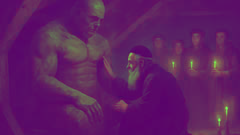
The magistrates, restless and ever resistant to their own fading relevance, began to conspire once more. Their schemes intersected with whispered threats from Prague’s outskirts—bands of ruffians eager to prove themselves, test the Golem, reclaim lost “honor.” A holiday approached, and with it, rumors flickered like will-o’-the-wisps that Josef might be used not as a guardian but as a weapon. The ghetto’s elders, conflicted, questioned the wisdom of keeping such power alive.
It was during Passover, a season when the entire community prepared for liberation and rebirth, that the fateful moment arrived. A mob—drunk with the promise of vengeance—stormed the quarter’s walls, throwing torches, howling for retribution. Josef moved protectively, a boulder amid chaos. He intercepted the mob’s front rank, pushing back their assault without fatal harm, quelling violence before it could claim a single life. But as he raised his hand to divert another blow, the figure of a youth tumbled into his path—panic in his eyes, a thrown stone in one trembling hand. The crowd gasped. The Golem paused, his protective instinct battling against the surge of power the crowd had awakened. The word “emet” glimmered on his brow. For a moment, the creation stood on the razor’s edge between justice and wrath, only Rabbi Loew’s prayers distant and faint anchoring his will.
Horrified by this brush with uncontrollable force, Loew realized the time had come. The boundary between man and miracle, faith and hubris, was too fine to hazard. That night, the rabbi gathered his most faithful in the attic of the Old-New Synagogue. By trembling candlelight, he led a final ritual. Each word was a thread severing Josef from the world of the living. With his finger, Loew erased the first letter from “emet,” changing the word to “met”—death. Instantly, the Golem’s great frame slackened. He toppled to the floor, silent once more, now lifeless clay. The community mourned by candlelight, weeping softly for their silent protector. The Golem’s body, it was told, was concealed in the rafters of the synagogue, awaiting a future’s call should danger threaten Prague again.
But the legend did not end. Stories of Josef grew with each telling—of the clay giant who protected the innocent, who saved children and rebuked lies, who chose not violence but shielded mercy. Parents retold it to frightened children by lamplight; lovers whispered it beneath shroud of dusk; lonely scholars etched his image into the wooden benches of the synagogue. In the memory of Prague’s Jewish Quarter, Josef endures—a symbol of courage, hope, and the fragile, sacred balance between power and humility.
Conclusion
Centuries have passed, yet the legend of the Golem lingers in the breath and stone of Prague. The Jewish Quarter, with its labyrinthine lanes and ancient synagogues, still guards whispers of Josef’s footfalls—echoes of his silent strength. Tourists now walk those streets, pausing before plaques, craning to spot the mythical guardian’s hidden resting place in the rafters. But locals know: the true heart of the tale lies not in clay bodies or supernatural feats, but in the courage to defend what’s sacred against impossible odds.
The Golem was more than protection. In him, Prague’s community found the hope to endure darkness, the wisdom to temper strength with mercy, and the humility to release even miracles when fate demanded. Rabbi Loew’s legacy survives in the prayers still chanted at twilight, in the resilience etched across the quarter’s stones, and in every hand reaching out in kindness when fear takes root.
To this day, as dusk settles over Prague’s riverside spires, some claim to hear faint, steadfast footfalls—reminders that legends endure not to terrify, but to unite, inspire, and illuminate the path from shadow into luminous hope. The Golem of Prague belongs not just to the past, but to anyone who stands—against cruelty, with courage, and for the fragile promise of peace in an ever-unsettled world.




